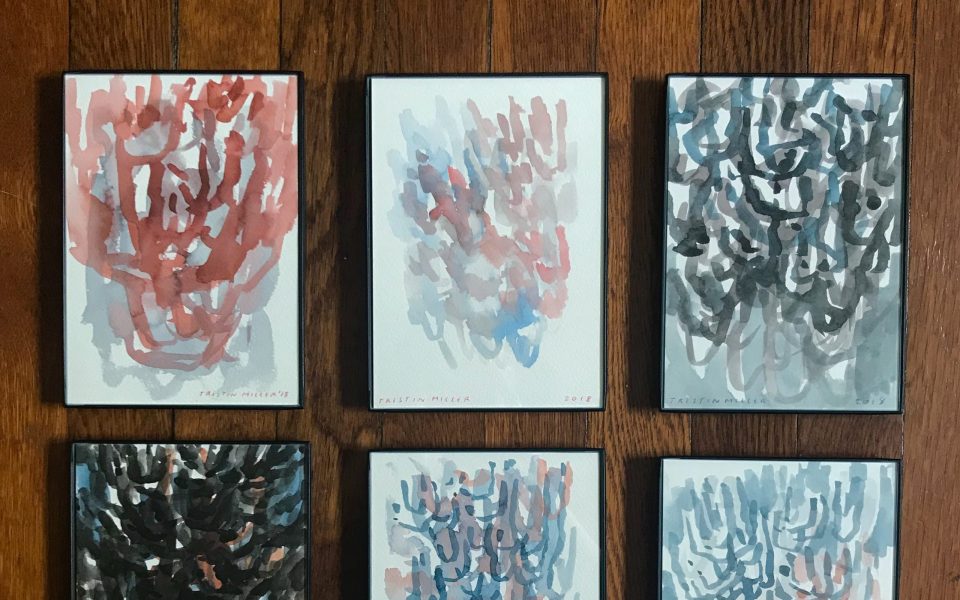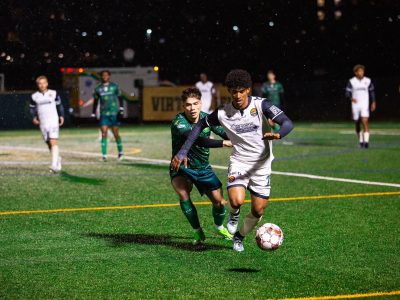The tidy grid of 36 petite watercolors catch the eyes first. The array of tiny potential Rorschach tests are nestled in a concave structure that might as well serve as metaphor for stepping into the painter’s subconscious.
This painter is Tristin Miller, whose latest exhibit Past in Present hangs in Irving Park Art & Frame in Greensboro. The show, up through the end of August, features selections from her last decade of work including whole sketchbooks, sumi-ink and micron-pen abstractions, and repetitive linear work, most of which have never been shown. Miller is also known locally for founding the Hand-to-Hand Market for indie craft and the Greensboro Zine Fest; she currently teaches a night drawing class for adults at the Cultural Arts Center for the Art Alliance of Greensboro.
“I love the repetition of doing something over and over again,” Miller says. “As I made the small paintings, I would tape them all up on the wall in the studio,” she says. “It was almost like keeping a calendar. I could see each one and give myself some time away from them but never said, ‘Oh, this one’s done.’ So there’s a dialogue going on not just between me and the work but between the works.”
The watercolors feature a limited palette: primaries, black contrasting with the white of paper.
“The title [of the exhibit] also suggests the accumulation of time,” she continues. “All these pieces, especially the smaller ones, I want them to show time spent because every minute of every hour is the most valuable resource I have and I will never get that back, so I choose to spend [it in a way that] is important and intentional.”
Miller plays with the concept of time in other ways, too; she reached for antique, 19th Century paper when creating four framed oil-pastel drawings on the far wall. The time she’s most interested in, though, is the present, which is reflected in her emphasis on process.[pullquote]Learn more at tristinmiller.com and visit the exhibit at 2105 W. Cornwallis Drive (GSO).[/pullquote]
“I was really liberated by my printmaking professor who said it’s about process and not finished product. He told me, ‘I think you’ve been focused on making art with a big “A” not art with a little “a”’ and that was when it clicked with me. Printmaking really liberated me to just fall in love with the process and make another and make another and make another. Every sketch you make is a sketch for the next sketch. It sets you up for your future work. But if you’re not clocking the mileage you’re never going to get anywhere in your self-discovery as an artist. You have to be disciplined and have a relationship with your work.”
Discipline doesn’t equate to rigidness, though. Miller says that a commitment to show up consistently, open to all possibilities, allows intuition and impulsivity to guide her work.
“I think my work is about water, the power of water,” Miller says. “I’m interested in the power of how nature can offset us and derail us, but it’s also really been the key, ancient metaphor for reflection on our lives.”
Japanese mythology, traditional arts, and Shinto and Zen Buddhist aesthetics particularly influence Miller. Ten years ago, she lived with a friend for a summer in a mountainous river valley area of Honshu, the largest Japanese island.
“The mountains were smack dab in your face, the forest was right there and you always heard the sound of water being channeled through little gullies,” she says.
For Miller, water’s intrigue largely stems from her dream life.
“Dreams are really underrated and say a lot about your waking life and subconscious life,” she says. “I’ve had a lot of dreams about tsunami waves or all the pipes bursting in my childhood home. Water represents your emotional life, so my work is not so much about the literal sense of water, it’s more about the metaphorical and symbolic meanings. How is nature showing up in your mind’s processing of your life experiences? What are the images that really stick with us?”
When she saw a friend’s photos from travel in Norway, she found herself questioning how a sudden flood would alter those picturesque, foggy mountain views that prompted memory of her time in Japan’s snow country. She answered that question with fragmented etchings with a white gel pen on the first and a watercolor wash of opaque, warm reds and blues overflowing from a river in the second. Those pieces most evidently demonstrate her interest in exploring sense of space and in communicating the sense of awe that accompanies overwhelming natural disasters. In other recent works, she turns her curiosity inward in the most literal sense.
Four nonfigurative corporeal landscapes suggest a sense of kinetic energy and bodily entropy, a mirror to the reality that our inner and outer environments are in constant flux. Anxious yellows stir up sour stomachs, mixed up in whirlwinds of bile, burgundy blood and messes of sapphire nerve endings. Our musculoskeletal home will one day dismantle itself. Valleys will flood. It’s a cycle born of the ever-present potential for betrayal in the face of fleeting vitality, whether from within or without. Miller chooses to engage anyway, day after day after day after day.
Join the First Amendment Society, a membership that goes directly to funding TCB‘s newsroom.
We believe that reporting can save the world.
The TCB First Amendment Society recognizes the vital role of a free, unfettered press with a bundling of local experiences designed to build community, and unique engagements with our newsroom that will help you understand, and shape, local journalism’s critical role in uplifting the people in our cities.
All revenue goes directly into the newsroom as reporters’ salaries and freelance commissions.





Leave a Reply